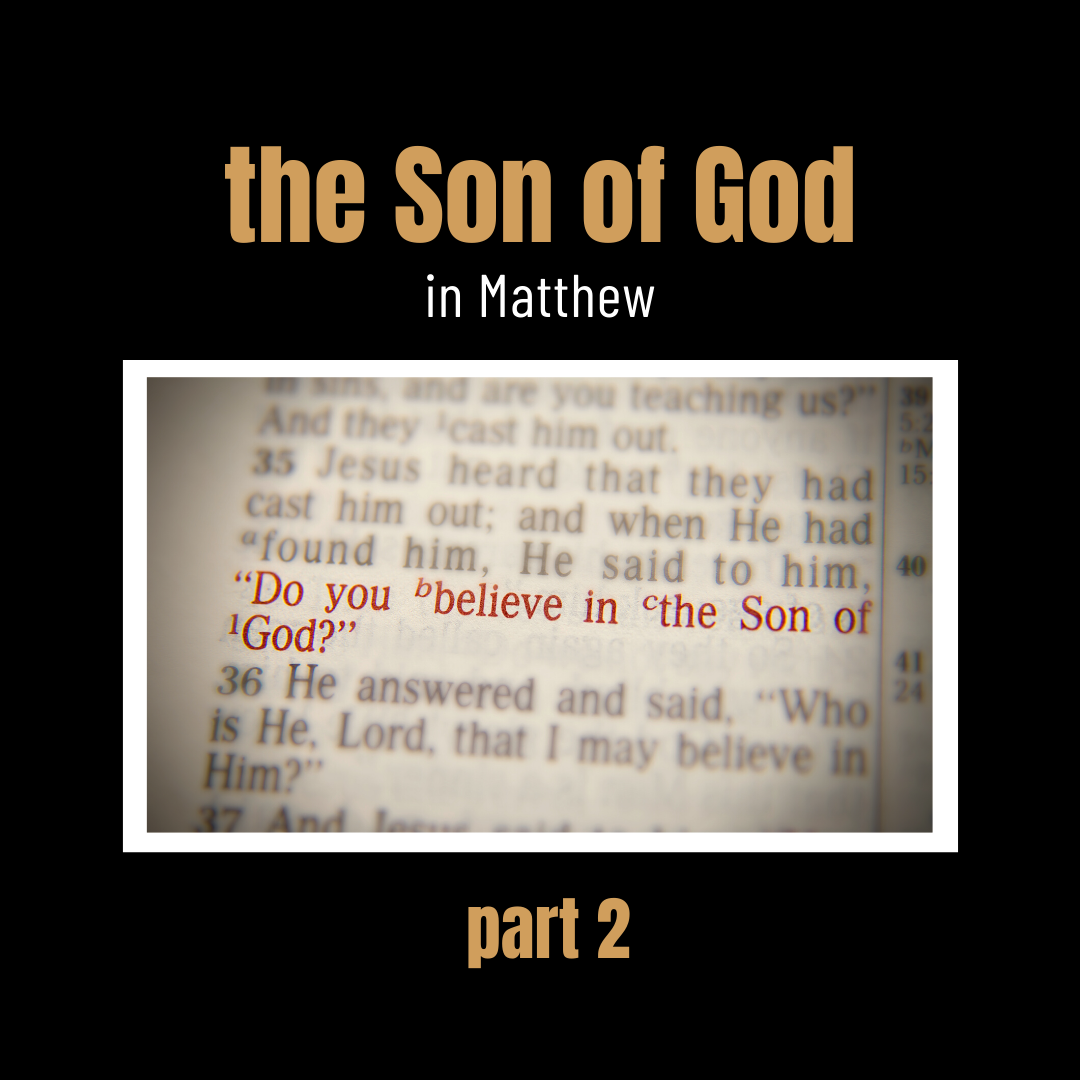The Son of God in Matthew, Part 2
The title "Son of God" is often thought of as a formula denoting the deity of Jesus Christ: The Son of God = God. Or it is seen as an emphasis on his deity. But, when applied to Christ, Scripture uses the title in a more nuanced way. Certainly “Son of God” can be used to assert that Jesus is God, equal with his Father and the Holy Spirit. But we also see that the "Son of God" is tempted by the devil, dies on a cross, and rises from the dead—none of which can apply to God, who cannot be tempted by evil, nor can he die (Jas 1:13; Is 40:28; Jer 10:10; Hab 1:12).
So how could Jesus be God and be tempted? How could he be God and die? To understand this, it is vital to remember that Jesus was Immanuel—God in the flesh. He added to his infinite deity the limitations of finite humanity (Mt 1:23). Jesus was fully man, in all ways like us in our humanness, yet without any stain of sin (Heb 2:17; 4:15). The divine nature of Christ was impervious to any temptation to sin and his divine nature could not die. Even Christ's human nature, as unstained by sin as it was, was not able to die because death only comes about as a result of sin (Gen 2:17; Rom 5:12; 6:23). It is only when the sinless Son of God took upon himself the sins of his people, through a literal imputation of their sins, that Christ could die. Jesus died as if he were the very sinners he came to rescue. In so doing, he saved his people from their sins, imputing his own righteousness to all who believe (Mt 1:21; Ro 4:5).
Christ is one person with two natures. This adds to the wonder of Jesus Christ, who though always fully God, added to himself human nature without losing any of his deity. Now let’s see what Matthew has to say on the subject.
The humanity of Christ is clearly in view when we read of his temptation after "fasting forty days and forty nights" (Mt 4:2). It was as a man, the “last Adam” if you will, that Jesus resisted the Tempter. Notice that the devil challenges Jesus on the basis of him being "the Son of God." Initiating two of the temptations with "if you are the Son of God" does not insinuate that the devil doubted Jesus' identity (Matt 4:3, 6). Rather, he assumes this identity of Christ as the grounds for his temptations’ allure.
Jesus, as Son, responds in the fullest expression of the term. Perfectly desiring to do his Father's will (as the Father himself testifies both before and after these temptations, Mt 3:17; 17:5), he relied on Scripture and the anointing of the Holy Spirit to resist the devil (Mt 4:1; Lk 4:1). Fight your fight against sin with the same weapons: dependence upon the Spirit of God, praying to God the Father, armed with the truth of God in Scripture.
As Matthew progresses, several confessions of Christ as the Son of God demarcate important developments in the gospel story. First, demons confess Jesus as such (8:29). The forces of hell are not unsure about the identity, authority, and mission of this Son. "O Son of God, Have you come here to torment us before the time?'" These demons knew Christ came, not only to save his people from their sins but to judge all of his enemies in due time (8:29).
Next, Jesus’ disciples, after being battered by a storm on the sea, witnessed Christ walking on the water. Peter, then, walked on the water as well but began to sink in fear and was promptly rebuked for his small faith. When the wind ceased, the disciples "worshiped him saying, 'Truly you are the Son of God'" (Mt 14:33). This confession is evidence of budding faith in a group so slow to understand the fullness of Christ's identity. They knew enough to worship him (a response owed to God alone) and to ascribe to him the title “Son of God.” Jesus is a man, but he is no ordinary man.
What we think about Jesus' identity is the most important thing about us. Matthew's gospel demands our answer. Jesus, he tells us, was curious what the people were saying in this respect:
Now when Jesus came into the district of Caesarea Philippi, he asked his disciples, "Who do people say that the Son of Man is?" And they said, "Some say John the Baptist, others say Elijah, and others Jeremiah or one of the prophets." He said to them, "But who do you say that I am?" Simon Peter replied, "You are the Christ, the Son of the living God" (Mt 16:13).
Peter's confession of Jesus as the Son of the living God is in some sense parallel to Jesus' initial question, “Who do people say that the Son of Man is?" Again, we cannot neatly delineate that "the Son of God" refers exclusively to Christ's deity and "the Son of Man" to his humanity. They must be interrelated in a more refined way (a topic I will further explore in future installments). Furthermore, Peter and his confession will be bedrock for the establishment of Christ's church (16:17ff), a turning point in Matthew's gospel, and the first explicit reference to the church in the NT. The Father is not only revealing saving knowledge about his Son to fallen sinners but collecting them into one church, the body of Christ (Mt 16:17-18).
If Christ’s church is to be gathered around this bedrock confession, then the anti-church, anti-Christ movement will surely oppose it. And this is the case in Matthew. As Christ's preaching of the gospel of the kingdom, not to mention his signs and wonders, put him on a collision course with most of the religious leaders, it is no surprise that the high priest himself was far from receptive of Jesus. At the zenith of escalation, Caiaphas the high priest puts Christ under oath, solemnly demanding, "I adjure you by the living God, tell us if you are the Christ, the Son of God." (Mt 26:63). Jesus answers by alluding to Daniel's "Son of Man" (Mt 26:64). These two verses, taken together, parallel "the Christ" with "the Son of God" and "the Son of Man," just as we saw in the context of Peter's confession (Mt 16:13-16). This was more than the high priest could bear. The only thing to do with Jesus was to curse him to the cross.
Adding to Christ's incomprehensible wounds of crucifixion, passers-by and "the chief priests, with the scribes and elders, mocked him” for claiming to be the Son of God (Mt 27:39-43). But it was not all grim at the cross. After Christ finished drinking dry the cup of God's wrath on behalf of his people, he "yielded up his spirit," the temple curtain was torn in two, a bunch of people were resurrected, and the earth quaked (Mt 27:51-53). It is at this point that the light of the atonement dawned on the minds of gentile sinners. "When the centurion and those who were with him, keeping watch over Jesus, saw the earthquake and what took place, they were filled with awe and said, 'Truly this was the Son of God'" (Matt 27:54). If these gentiles could come to confess Jesus Christ as the Son of God, certainly disciples in any and all nations could as well.
The Son of God not only died on the cross but was raised again physically, exercising kingly authority over death itself. It is the risen Son whom Christ's disciples worship as they had done in that boat on the Sea of Galilee (Mt 28:9, 17). And it is this risen Son of God who commissions his church to go make disciples by teaching them, among other things, that he is equal in glory with his Father and with the Holy Spirit, as the trinitarian baptismal formula illustrates: "Go therefore and make disciples of all nations, baptizing them in the name of the Father and of the Son and of the Holy Spirit" (Mt 28:19).
Therefore, when Jesus is called the Son of God, remember that Jesus is the unique God-man, our Lord and our Savior, our Brother and our King, and join with all the earth in his everlasting worship!

